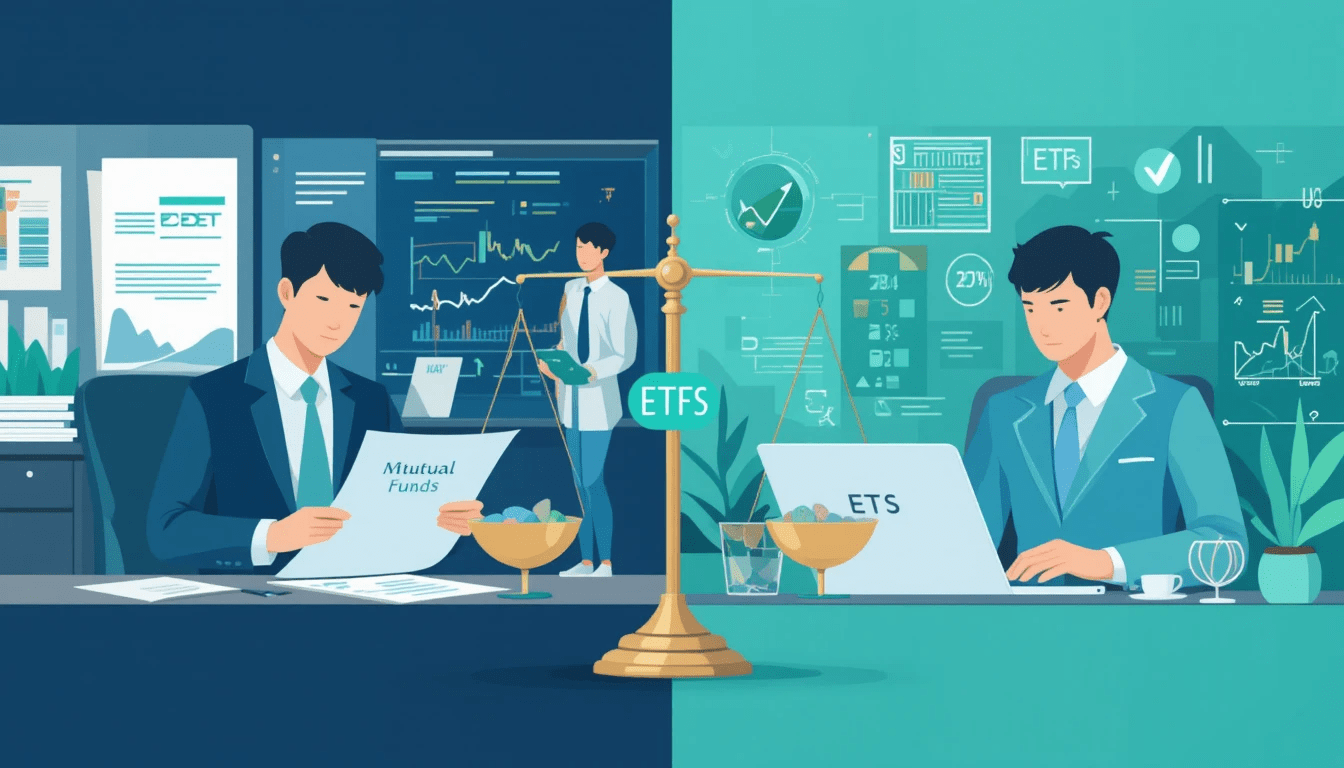Investing has become more accessible than ever. With countless options available, two of the most popular investment vehicles — mutual funds and exchange-traded funds (ETFs) — often spark confusion among new and seasoned investors alike. While both offer a diversified approach to investing, they differ in structure, costs, trading flexibility, and suitability depending on your financial goals.
In this article, we will explore mutual funds and ETFs in-depth, comparing their features, pros, and cons to help you determine which one is better suited for you.
Chapter 1: What Are Mutual Funds and ETFs?
Mutual Funds Explained
A mutual fund is a professionally managed investment fund that pools money from multiple investors to purchase a diversified portfolio of stocks, bonds, or other securities. These are typically managed by a fund manager or a team of analysts who make decisions based on the fund’s investment strategy.
Structure: Open-ended (can issue unlimited shares)
Pricing: Shares priced once a day after market close
Management: Active or passive
Minimum Investment: Often required (e.g., $500 to $3,000)
ETFs Explained
ETFs, or exchange-traded funds, are also pooled investment vehicles, but they trade like stocks on a stock exchange. They can be bought and sold throughout the trading day, and their prices fluctuate like individual stocks.
Structure: Open-ended, but traded on exchanges
Pricing: Real-time, based on market demand
Management: Typically passive (but active ETFs exist)
Minimum Investment: None (you can buy as little as one share)

Chapter 2: Key Differences Between Mutual Funds and ETFs
| Feature | Mutual Funds | ETFs |
|---|---|---|
| Trading | Once per day at NAV | Throughout the day like a stock |
| Minimum Investment | Often high (e.g., $1,000+) | Typically low; depends on share price |
| Management | Often actively managed | Mostly passively managed |
| Costs | May include front-end/back-end loads | Usually low expense ratios and no loads |
| Tax Efficiency | Less tax-efficient due to internal turnover | More tax-efficient due to “in-kind” transfers |
| Transparency | Holdings disclosed quarterly | Holdings disclosed daily |
Chapter 3: Management Style — Active vs Passive
Active Management (Common in Mutual Funds)
In active management, fund managers aim to beat the market by selecting stocks or bonds they believe will outperform. This can result in higher returns, but also often leads to higher costs due to management fees and trading expenses.
Pros:
Potential to outperform the market
More flexibility in investment choices
Ideal for niche or specialized sectors
Cons:
Higher fees (typically 1%–2%)
Manager performance may vary
Less tax-efficient due to frequent trades
Passive Management (Common in ETFs)
ETFs are usually index funds, meaning they track a specific index like the S&P 500 or Nasdaq-100. The goal is to mirror the performance of the index, not beat it.
Pros:
Lower fees (as low as 0.03%)
More predictable returns
Tax-efficient
Cons:
No chance to outperform the market
Limited to index composition
Less flexibility in downturns
Chapter 4: Cost Comparison
When it comes to investing, costs matter a lot — especially over the long term. Here’s how mutual funds and ETFs compare.
Mutual Fund Fees:
Expense Ratio: 0.50%–2.00% annually
Front-end Load: Fee at the time of purchase (e.g., 5%)
Back-end Load: Fee when selling shares
12b-1 Fees: Marketing and distribution expenses
ETF Fees:
Expense Ratio: 0.03%–0.75%
Brokerage Commission: Generally $0 with most online brokers
Bid-Ask Spread: Small trading cost, especially in low-volume ETFs
Bottom Line: ETFs are usually more cost-effective than mutual funds, especially for DIY investors using online platforms.
Chapter 5: Tax Efficiency
Taxes can eat into your investment returns. Here’s how each type of fund handles taxes:
Mutual Funds and Capital Gains
When a mutual fund manager sells securities within the fund, capital gains are passed on to all investors — regardless of whether they sold their shares or not. This can result in an unexpected tax bill at the end of the year.
ETFs and the “In-Kind” Advantage
ETFs use a mechanism called in-kind creation/redemption, which allows them to avoid selling securities to meet investor redemptions. As a result, ETFs tend to generate fewer capital gains distributions, making them more tax-efficient.
Chapter 6: Liquidity and Flexibility
ETFs: Superior Liquidity
Because ETFs trade like stocks, you can:
Buy/sell at any time during market hours
Use limit orders, stop-loss, and margin
See price movements in real-time
This makes ETFs attractive to investors who want real-time control over their investments.
Mutual Funds: Less Flexibility
You can only buy or sell at the end-of-day NAV, and there’s often a processing delay. This can be limiting for investors who want to react quickly to market news.
Chapter 7: Accessibility and Platforms
Mutual Funds: Traditional Approach
Many mutual funds are sold through:
Brokerages
Retirement plans
Financial advisors
They often come with higher account minimums and less transparency.
ETFs: Tech-Friendly Investing
ETFs are widely available on:
Online brokerages (Robinhood, Fidelity, Vanguard)
Retirement accounts
Robo-advisors (Wealthfront, Betterment)
They are easier to access for beginner investors, especially those with limited capital.
Chapter 8: Suitability by Investor Type
Mutual Funds May Be Better If You Are:
A long-term investor with large capital
Interested in professional active management
Investing via a 401(k) or retirement plan
Prefer hands-off investing with guidance
ETFs May Be Better If You Are:
A DIY investor using online platforms
Looking for lower costs and tax efficiency
Want to trade during the day
Prefer greater transparency
Chapter 9: Real-Life Scenarios
Scenario 1: Sarah, the Busy Professional
Sarah earns a high income and contributes to her company’s 401(k) plan. She prefers not to manage her own investments.
Best Choice: Mutual Funds (especially target-date or managed funds)
Scenario 2: Jason, the DIY Investor
Jason is 28, tech-savvy, and likes to manage his investments using Robinhood. He prefers low-cost index investing.
Best Choice: ETFs
Scenario 3: Linda, the Retiree
Linda wants steady income and tax efficiency. She’s withdrawing funds from her taxable account and doesn’t want surprise tax bills.
Best Choice: ETFs (especially bond or dividend ETFs)
Chapter 10: Popular Mutual Funds and ETFs
Top Mutual Funds (as of 2024):
Vanguard 500 Index Fund (VFIAX)
Fidelity Contrafund (FCNTX)
American Funds Growth Fund of America (AGTHX)
Top ETFs (as of 2024):
SPDR S&P 500 ETF (SPY)
Vanguard Total Stock Market ETF (VTI)
iShares MSCI Emerging Markets ETF (EEM)
Chapter 11: Final Comparison — Pros and Cons
| Category | Mutual Funds | ETFs |
|---|---|---|
| Diversification | ✅ | ✅ |
| Cost | ❌ (higher) | ✅ (lower) |
| Tax Efficiency | ❌ | ✅ |
| Trading Flexibility | ❌ | ✅ |
| Professional Management | ✅ | ✅ (if actively managed) |
| Ease of Use | ✅ (with advisor) | ✅ (online platforms) |

Chapter 12: Which Is Better for You?
There is no one-size-fits-all answer. The better choice depends on your:
Financial goals
Investment experience
Risk tolerance
Tax situation
Platform preference
Here’s a quick decision guide:
| If You Value… | Go With… |
|---|---|
| Hands-off management | Mutual Funds |
| Day trading ability | ETFs |
| Lower costs | ETFs |
| Tax efficiency | ETFs |
| Professional strategies | Mutual Funds |
| Online trading platforms | ETFs |
| Employer retirement plans | Mutual Funds |
Conclusion
Both mutual funds and ETFs offer powerful tools for building wealth through diversified investing. If you’re looking for simplicity, professional guidance, and retirement account options, mutual funds might be the better fit. On the other hand, if you want flexibility, lower fees, and tax efficiency, ETFs are likely your best choice.
What is the main difference between a mutual fund and an ETF?
Mutual funds are typically actively managed and trade once per day at the end-of-day net asset value (NAV), while ETFs are usually passively managed and can be bought and sold throughout the trading day like stocks.Which is better for beginners: mutual funds or ETFs?
ETFs are often more beginner-friendly due to lower costs and easy access through online brokerages. However, mutual funds can be better for hands-off investors who prefer professional management.Are ETFs cheaper than mutual funds?
Generally, yes. ETFs have lower expense ratios and no sales loads, making them more cost-effective over time.Can I invest in both mutual funds and ETFs?
Yes, many investors use a mix of both to balance costs, flexibility, and investment strategies.Do ETFs pay dividends?
Yes, many ETFs distribute dividends from the underlying stocks or bonds they hold, either monthly or quarterly.Are mutual funds actively managed?
Most mutual funds are actively managed, but there are also passive mutual funds that track indices.Are ETFs tax-efficient?
Yes, ETFs are generally more tax-efficient than mutual funds due to their unique “in-kind” redemption mechanism that minimizes capital gains.Is there a minimum investment for ETFs?
No, you can typically buy a single share of an ETF, which could be as low as $10–$100 depending on the ETF.Do mutual funds have higher returns than ETFs?
Not necessarily. Actively managed mutual funds aim to beat the market but often underperform after fees. Many ETFs perform competitively by tracking the broader market.Can I trade ETFs like stocks?
Yes, ETFs can be traded throughout the day during market hours, with real-time pricing and trading tools.Which is better for retirement accounts: mutual funds or ETFs?
Mutual funds are more common in 401(k) plans, but ETFs are increasingly available in IRAs and self-directed retirement accounts.Do ETFs have management fees?
Yes, ETFs have expense ratios, but they are typically much lower than mutual fund fees.Can I lose money with mutual funds or ETFs?
Yes, both are subject to market risk, and your investment can decline in value based on the performance of the underlying assets.Are mutual funds good for long-term investing?
Yes, mutual funds are a popular choice for long-term investors, especially for retirement or college savings.How often do ETFs update their holdings?
Most ETFs disclose their holdings daily, offering greater transparency compared to mutual funds, which may only disclose quarterly.What is NAV in a mutual fund?
NAV (Net Asset Value) is the per-share value of a mutual fund calculated at the end of each trading day.Can I set automatic investments in ETFs like I can with mutual funds?
Some brokerages allow automated ETF investments, but it’s more common and easier with mutual funds.Are there ETFs that are actively managed?
Yes, although most ETFs are passively managed, there is a growing number of actively managed ETFs.Which is more liquid: mutual funds or ETFs?
ETFs are more liquid because they trade on exchanges throughout the day, unlike mutual funds which only trade once daily.How do I choose between a mutual fund and an ETF?
Consider your investment goals, tax situation, desired level of involvement, and cost sensitivity. ETFs may be better for cost-conscious, active investors, while mutual funds suit those seeking active management and long-term planning.







![The Cheapest Car Insurance Companies in the USA [2025 Edition]](https://happymod.fun/wp-content/uploads/2025/04/piclumen-1745169121216-110x85.png)











